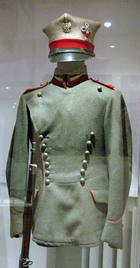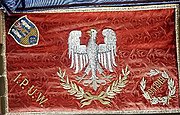15th Poznań Uhlans Regiment
| 15 Pułk Ułanów Poznańskich | |
|---|---|
 
|
|
| Active | 1918-1939, 1942-1947 |
| Country | Poland |
| Branch | Land forces |
| Type | Cavalry, Mounted Infantry, Mechanized Infantry, Armoured |
| Garrison/HQ | Poznań |
| Nickname(s) | Rogate, czerwone czorty (Horned, red devils) |
| Colors | white and red |
| Anniversaries | 23 April |
| Engagements | Greater Poland Uprising (1918-1919), Polish-Soviet War, September Campaign, Italian Campaign (World War II) |
| Commanders | |
| Ceremonial chief | President of City of Poznań |
| Notable commanders |
Władysław Anders, Stanisław Grzmot-Skotnicki |
| Insignia | |
| Pennant | |
| Regimental colours of 15th Poznań Uhlans Reg. (reverse) |  |
15th Poznań Uhlans Regiment (Polish: 15 Pułk Ułanów Poznańskich; 15 p.uł.) – unit of Polish cavalry, part of Greater Polands Army, Polish Army of Second Republic and Polish Armed Forces in the West during World War II.
The Regimental colours were founded by females from the Poznań society Ognisko Żołnierza Polskiego. The regiment received the colours from the hands of Gen. Józef Dowbor-Muśnicki in Poznań on 29 July 1919. Despite the fact that Colours were irregular to Polish Army military code, the standard was used for all the time of the regiment's existence during the interbellum. During the occupation, the standard was kept in the Visitationist Church in Warsaw. The nuns, after the assassination of Franz Kutschera, cut off the image of the Holy Mother and burned the rest of standard. The standard was reconstructed, with usage of parts of previous colours in 1960. Currently the Standard is kept in Greater Polands Military Museum in Poznań.
15th Uhlans Regiment was first formed as a part of the Army of the Duchy of Warsaw. Later, during the November Uprising, volunteers from the Prussian partition created the Poznań Cavalry Regiment (Polish: Pułk Jazdy Poznańskiej). Close to the west wall of the St Anthony of Padua's Church is a monument of the 15th Poznań Uhlan Regiment.
...
Wikipedia
